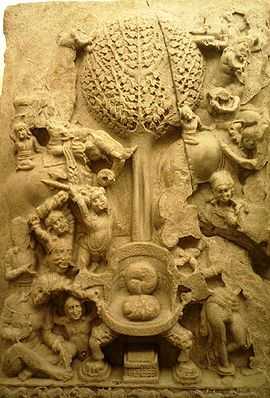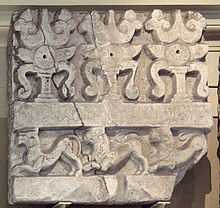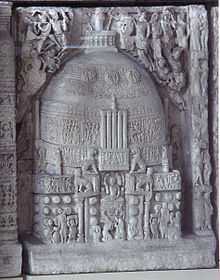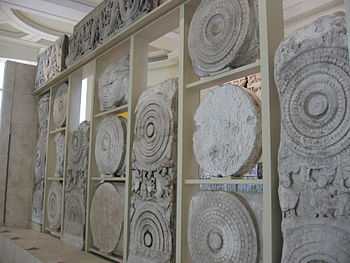Amaravati Marbles
|
The sculptures as displayed in the British Museum | |
| Material | Limestone |
|---|---|
| Created | 2nd century AD |
| Discovered | 1797 |
| Present location | British Museum, London; Government Museum, Chennai |
| Identification | 1880,0709.1-120 (British Museum) |
Description
The figurative sculptures are nearly all in relief, with many of the most crowded scenes illustrating some of the Jataka tales, a large body of literature with complex accounts of the previous lives of the Buddha. The collection in the museum in Chennai (formerly Madras) has a large number of sculptures in relief, which they have classified by four periods of activity starting in the second century BC and stretching to the second century AD. The first period covers the 100 years between 200 and 100 BC, the second period covers 200 years from 100 BC to AD 100, the third covers AD 100 to 150, and the fourth covers 150 to 200. Early interest in the stupa and its sculptures was in part because it was wrongly thought to contain early evidence of Christianity in India.[3]
The collection in the British Museum consists of over 120 different pieces made from a limestone called Palnad marble.[4] The segments can be divided into a number of categories, including parts of the stupa's toranas or gateways, and the symbolic wall connecting them, and parts of the stone facing of the mound dome of the stupa itself. They include pillars, crossbars and copings, drum frieze panels and slabs, pillar fragments, two guardian lions and a number of miscellaneous pieces, some of which date from later periods. In total, they represent the most important collection of ancient Indian sculpture outside the sub-continent. The Amaravati or Elliot Marbles have been compared with the Elgin Marbles, but unlike the Greek sculptures, their ownership has not been contested.[4]
History
The stupa's construction began in the time of the Indian ruler Ashoka, who ruled approximately 269-232 BC. At the end of his rule began the 450-year-long rule of the Satavahana dynasty, with its capital at Amaravati. An Asoka pillar bearing the inscription of Ashoka shows the earliest date, but the stupa was extended to 50 metres in diameter, becoming one of the largest in southern India. This stupa was covered in limestone panels carved mainly with Buddhist mythology. At some point the stupa also gained a protective wall, but the whole site was abandoned as Hinduism replaced Buddhism in most of India in the medieval period. The stupa collapsed and was ignored by the local population for 500 years.[5]
Recovery

Westerners were first alerted to the ruins of the Stupa at Amaravati after a visit in 1797 by Major Colin Mackenzie.[6] On the right bank of the Krishna River[7] in the Andhra district of southeast India, Mackenzie came across a huge Buddhist construction built of bricks and faced with slabs of limestone.[8] By the time he returned in 1816, indiscriminate excavations had already destroyed what remained of the structure and many of the bricks had been reused to build local houses.[6] Mackenzie carried out further excavations, recorded what he saw and drew a plan of the stupa.[1]
In 1845, Sir Walter Elliot of the Madras Civil Service explored the area around the stupa and excavated near the west gate of the railing, removing many sculptures to Madras (now Chennai). They were kept outside the local college before being transported to the Madras Museum. At this time India was run by the East India Company and it was to that company that the curator of the museum appealed. The curator Dr Edward Balfour was concerned that the artefacts were deteriorating so in 1853 he started to raise a case for them to be moved. By 1855 he had arranged for both photographs and drawings to be made of the artefacts now called the Elliot Marbles. 75 photographs taken by Captain Linnaeus Tripe are now in the British Library.[9] The sculptures were exported to London in 1859.[4] Robert Sewell made further excavations in the 1880s, recording his excavations in some detail with drawings and sketches but not in the detail that would now be expected.[6]
The sculptures in London were deposited in the British Museum in 1880, where for a long time they remained on the museum's main stairwell until they were removed for safekeeping during World War Two. They re-emerged in the 1950s but it was obvious that the atmosphere in the museum was causing them to deteriorate. They were moved to an air conditioned basement in 1959 where they remained for over thirty years until a special gallery could be constructed.[4]
Current status
The British Museum's Joseph Hotung Gallery was opened in 1992 to feature Asian art. Adjacent to this gallery, the marbles are displayed in a special glass room with controlled humidity and air conditioning.[4] The new gallery includes a reconstructed section of the stupa and the protective wall that was around the stupa.[5]
Plans have also been put in place to create a purpose built exhibition space for the sculptures still in India. Those marbles not in an air conditioned store were said to show signs of damage from the atmosphere and salt.[4] The Chennai museum has plans for an air-conditioned gallery to install the sculptures, but these goals have yet to be realised.[5]
Gallery
| Wikimedia Commons has media related to Buddhist art from Amaravati. |
-

Dome slab from the 2nd century stupa
-

Frieze from Amaravati depicting the stupa
-

Slab of the Great Stupa with the Buddha standing at the entrance to the monument
-
Gazelles facing each other
References
- ↑ 1.0 1.1 Government Museum Website Government Museum homepage (and then click on "Archaeology", Chennai Museum, Tamilnadu, retrieved 11 January 2014
- ↑ Amarati search results, British Museum Collection, retrieved 19 December 2013
- ↑ Buddhist Sculptures, Government Museum, Chennai, retrieved 21 December 2013
- ↑ 4.0 4.1 4.2 4.3 4.4 4.5 Roy, Amit (December 1992). "Out of Amatavati". IndiaToday. Retrieved 21 December 2013.
- ↑ 5.0 5.1 5.2 "History in stone". The Hindu. 28 January 2002. Retrieved 22 December 2013.
- ↑ 6.0 6.1 6.2 Buddha, ancientindia.co.uk, retrieved 19 December 2013
- ↑ Erdosy, George et al. (1995). The archaeology of early historic South Asia: the emergence of cities and states (1. publ. ed.). Cambridge: Cambridge University Press. p. 146. ISBN 0521376955.
- ↑ Amravati, PilgrimTrips, retrieved 12 January 2014
- ↑ Photos of the Elliot Marbles, Linnaeus Tripe, British Library, retrieved 19 December 2013
Further reading
- Knox R, Amaravati - Buddhist Sculpture from the Great Stupa, London, British Museum Press
- Zwalf W, Buddhism: Art and Faith, London, British Museum
- Barrett D, Studies in Indian Sculpture and Painting, London
| |||||||||||||||||||||||||||||||||||||||||||||||||||

